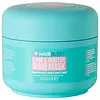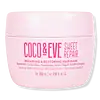What's inside
What's inside
 Key Ingredients
Key Ingredients

 Benefits
Benefits

 Concerns
Concerns

 Ingredients Side-by-side
Ingredients Side-by-side

Water
Skin ConditioningCetearyl Alcohol
EmollientCocos Nucifera Fruit Extract
EmollientDimethicone
EmollientBehentrimonium Chloride
PreservativeC15-19 Alkane
SolventGlycerin
HumectantCetyl Alcohol
EmollientPhenoxyethanol
PreservativeCetrimonium Chloride
AntimicrobialParfum
MaskingPentylene Glycol
Skin ConditioningPotassium Sorbate
PreservativeButylene Glycol
HumectantArgania Spinosa Kernel Oil
EmollientEthylhexylglycerin
Skin ConditioningHelianthus Annuus Seed Extract
Skin ConditioningTriticum Vulgare Bran Extract
Skin ConditioningAvena Strigosa Seed Extract
Skin ConditioningPersea Gratissima Oil
Skin ConditioningTocopherol
Antioxidant1,2-Hexanediol
Skin ConditioningCaprylyl Glycol
EmollientLecithin
EmollientCitric Acid
BufferingAmyl Cinnamal
PerfumingCoumarin
PerfumingCI 16035
Cosmetic ColorantWater, Cetearyl Alcohol, Cocos Nucifera Fruit Extract, Dimethicone, Behentrimonium Chloride, C15-19 Alkane, Glycerin, Cetyl Alcohol, Phenoxyethanol, Cetrimonium Chloride, Parfum, Pentylene Glycol, Potassium Sorbate, Butylene Glycol, Argania Spinosa Kernel Oil, Ethylhexylglycerin, Helianthus Annuus Seed Extract, Triticum Vulgare Bran Extract, Avena Strigosa Seed Extract, Persea Gratissima Oil, Tocopherol, 1,2-Hexanediol, Caprylyl Glycol, Lecithin, Citric Acid, Amyl Cinnamal, Coumarin, CI 16035
Water
Skin ConditioningCetearyl Alcohol
EmollientCetrimonium Chloride
AntimicrobialAnanas Sativus Fruit Extract
Skin ConditioningPsidium Guajava Fruit Extract
AstringentCocos Nucifera Fruit Extract
EmollientMusa Sapientum Fruit Extract
Skin ConditioningHydrolyzed Pea Protein
EmollientPseudozyma Epicola/Argania Spinosa Kernel Oil/Camellia Japonica Seed Oil/Camellia Sinensis Seed Oil/Sunflower Seed Oil/Sweet Almond Oil Ferment Extract
Ficus Carica Fruit Extract
HumectantNephelium Lappaceum Branch/Fruit/Leaf Extract
Skin ConditioningHydrolyzed Rice Protein
Skin ConditioningPersea Gratissima Oil
Skin ConditioningHydrolyzed Hyaluronic Acid
HumectantHydrolyzed Hemp Seed Extract
Skin ConditioningSodium Hyaluronate
HumectantBehentrimonium Chloride
PreservativeEthylhexyl Palmitate
EmollientGuar Hydroxypropyltrimonium Chloride
Skin ConditioningGlyceryl Stearate
EmollientDipalmitoylethyl Hydroxyethylmonium Methosulfate
Potassium Sorbate
PreservativeBehenyl/Stearyl Aminopropanediol Esters
Propylene Glycol
HumectantQuaternium-80
Glycerin
HumectantCitric Acid
BufferingTocopherol
AntioxidantParfum
MaskingCI 17200
Cosmetic ColorantCI 19140
Cosmetic ColorantBenzyl Alcohol
PerfumingHexyl Cinnamal
PerfumingBenzoic Acid
MaskingTetrasodium Glutamate Diacetate
Sorbic Acid
PreservativeCoumarin
PerfumingWater, Cetearyl Alcohol, Cetrimonium Chloride, Ananas Sativus Fruit Extract, Psidium Guajava Fruit Extract, Cocos Nucifera Fruit Extract, Musa Sapientum Fruit Extract, Hydrolyzed Pea Protein, Pseudozyma Epicola/Argania Spinosa Kernel Oil/Camellia Japonica Seed Oil/Camellia Sinensis Seed Oil/Sunflower Seed Oil/Sweet Almond Oil Ferment Extract, Ficus Carica Fruit Extract, Nephelium Lappaceum Branch/Fruit/Leaf Extract, Hydrolyzed Rice Protein, Persea Gratissima Oil, Hydrolyzed Hyaluronic Acid, Hydrolyzed Hemp Seed Extract, Sodium Hyaluronate, Behentrimonium Chloride, Ethylhexyl Palmitate, Guar Hydroxypropyltrimonium Chloride, Glyceryl Stearate, Dipalmitoylethyl Hydroxyethylmonium Methosulfate, Potassium Sorbate, Behenyl/Stearyl Aminopropanediol Esters, Propylene Glycol, Quaternium-80, Glycerin, Citric Acid, Tocopherol, Parfum, CI 17200, CI 19140, Benzyl Alcohol, Hexyl Cinnamal, Benzoic Acid, Tetrasodium Glutamate Diacetate, Sorbic Acid, Coumarin
Ingredients Explained
These ingredients are found in both products.
Ingredients higher up in an ingredient list are typically present in a larger amount.
This ingredient is a preservative and often used for it's anti-static properties. You'll most likely see this ingredient in hair conditioners.
It does not cause irritation or sensitization in leave-on products at 1-5%.
Cetearyl alcohol is a mixture of two fatty alcohols: cetyl alcohol and stearyl alcohol. It is mainly used as an emulsifier. Emulsifiers help prevent the separation of oils and products. Due to its composition, it can also be used to thicken a product or help create foam.
Cetearyl alcohol is an emollient. Emollients help soothe and hydrate the skin by trapping moisture.
Studies show Cetearyl alcohol is non-toxic and non-irritating. The FDA allows products labeled "alcohol-free" to have fatty alcohols.
This ingredient is usually derived from plant oils such as palm, vegetable, or coconut oils. There is debate on whether this ingredient will cause acne.
Due to the fatty acid base, this ingredient may not be Malassezia folliculitis safe.
Learn more about Cetearyl AlcoholThis ingredient is a preservative, antimicrobial, and emulsifier. It is often used in cosmetics for its ability to cleanse, condition, and reduce static.
Cetrimonium chloride is a quaternary ammonium salt, meaning it has a water-soluble structure.
Citric Acid is an alpha hydroxy acid (AHA) naturally found in citrus fruits like oranges, lemons, and limes.
Like other AHAs, citric acid can exfoliate skin by breaking down the bonds that hold dead skin cells together. This helps reveal smoother and brighter skin underneath.
However, this exfoliating effect only happens at high concentrations (20%) which can be hard to find in cosmetic products.
Due to this, citric acid is usually included in small amounts as a pH adjuster. This helps keep products slightly more acidic and compatible with skin's natural pH.
In skincare formulas, citric acid can:
While it can provide some skin benefits, research shows lactic acid and glycolic acid are generally more effective and less irritating exfoliants.
Most citric acid used in skincare today is made by fermenting sugars (usually from molasses). This synthetic version is identical to the natural citrus form but easier to stabilize and use in formulations.
Read more about some other popular AHA's here:
Learn more about Citric AcidCocos Nucifera Fruit Extract comes from the meat of the coconut fruit. It is an emollient and skin conditioner with antioxidant properties.
Coconut fruit is naturally rich in amino acids, sugars, and nutrients including Vitamin C and small amounts of vitamin B. Malic acid can also be found in coconut fruit extract.
Coumarins are a group of substances found naturally in plants. There are over 1300 types of coumarins identified. It has a natural vanilla scent.
Coumarin is an identified EU known allergy, meaning it may cause an allergic reaction when applied to the skin.
In many countries, coumarin is banned as a food additive. However, it can be found in soaps, tobacco products, and some alcohol drinks.
Plants use coumarins as a chemical defense. Some plants that have coumarins include lavender, tonka beans, and yellow clovers.
Learn more about CoumarinGlycerin is already naturally found in your skin. It helps moisturize and protect your skin.
A study from 2016 found glycerin to be more effective as a humectant than AHAs and hyaluronic acid.
As a humectant, it helps the skin stay hydrated by pulling moisture to your skin. The low molecular weight of glycerin allows it to pull moisture into the deeper layers of your skin.
Hydrated skin improves your skin barrier; Your skin barrier helps protect against irritants and bacteria.
Glycerin has also been found to have antimicrobial and antiviral properties. Due to these properties, glycerin is often used in wound and burn treatments.
In cosmetics, glycerin is usually derived from plants such as soybean or palm. However, it can also be sourced from animals, such as tallow or animal fat.
This ingredient is organic, colorless, odorless, and non-toxic.
Glycerin is the name for this ingredient in American English. British English uses Glycerol/Glycerine.
Learn more about GlycerinParfum is a catch-all term for an ingredient or more that is used to give a scent to products.
Also called "fragrance", this ingredient can be a blend of hundreds of chemicals or plant oils. This means every product with "fragrance" or "parfum" in the ingredients list is a different mixture.
For instance, Habanolide is a proprietary trade name for a specific aroma chemical. When used as a fragrance ingredient in cosmetics, most aroma chemicals fall under the broad labeling category of “FRAGRANCE” or “PARFUM” according to EU and US regulations.
The term 'parfum' or 'fragrance' is not regulated in many countries. In many cases, it is up to the brand to define this term.
For instance, many brands choose to label themselves as "fragrance-free" because they are not using synthetic fragrances. However, their products may still contain ingredients such as essential oils that are considered a fragrance by INCI standards.
One example is Calendula flower extract. Calendula is an essential oil that still imparts a scent or 'fragrance'.
Depending on the blend, the ingredients in the mixture can cause allergies and sensitivities on the skin. Some ingredients that are known EU allergens include linalool and citronellol.
Parfum can also be used to mask or cover an unpleasant scent.
The bottom line is: not all fragrances/parfum/ingredients are created equally. If you are worried about fragrances, we recommend taking a closer look at an ingredient. And of course, we always recommend speaking with a professional.
Learn more about ParfumPersea Gratissima Oil is also known as avocado oil.
Avocado Oil has antioxidant properties. It is mostly made up of the glycerides of fatty acids. About 67% of these fatty acids is made up of oleic acid. Palmitic acid and linoleic acid are also present.
These fatty acids help hydrate and soften the skin. It may increase collagen content in the skin. Collagen helps keep your skin plump and firm. This ingredient helps reduce inflammation and has not shown to clog pores.
This ingredient may not be fungal-acne safe due to its high fatty acid content.
Avocados also have B vitamins, vitamin K, vitamin C, vitamin E, and potassium.
Learn more about Persea Gratissima OilPotassium Sorbate is a preservative used to prevent yeast and mold in products. It is commonly found in both cosmetic and food products.
This ingredient comes from potassium salt derived from sorbic acid. Sorbic acid is a natural antibiotic and effective against fungus.
Both potassium sorbate and sorbic acid can be found in baked goods, cheeses, dried meats, dried fruit, ice cream, pickles, wine, yogurt, and more.
You'll often find this ingredient used with other preservatives.
Learn more about Potassium SorbateTocopherol (also known as Vitamin E) is a common antioxidant used to help protect the skin from free-radicals and strengthen the skin barrier. It's also fat soluble - this means our skin is great at absorbing it.
Vitamin E also helps keep your natural skin lipids healthy. Your lipid skin barrier naturally consists of lipids, ceramides, and fatty acids. Vitamin E offers extra protection for your skin’s lipid barrier, keeping your skin healthy and nourished.
Another benefit is a bit of UV protection. Vitamin E helps reduce the damage caused by UVB rays. (It should not replace your sunscreen). Combining it with Vitamin C can decrease sunburned cells and hyperpigmentation after UV exposure.
You might have noticed Vitamin E + C often paired together. This is because it is great at stabilizing Vitamin C. Using the two together helps increase the effectiveness of both ingredients.
There are often claims that Vitamin E can reduce/prevent scarring, but these claims haven't been confirmed by scientific research.
Learn more about TocopherolWater. It's the most common cosmetic ingredient of all. You'll usually see it at the top of ingredient lists, meaning that it makes up the largest part of the product.
So why is it so popular? Water most often acts as a solvent - this means that it helps dissolve other ingredients into the formulation.
You'll also recognize water as that liquid we all need to stay alive. If you see this, drink a glass of water. Stay hydrated!
Learn more about Water